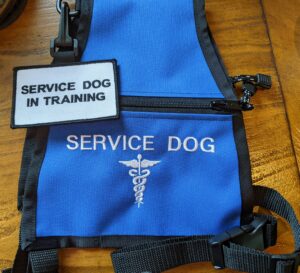Any service dog who engages in public access work needs to be identified as a service dog. In many cases, a vest is the most practical way to do this. Choosing the right vest is important. The appearance of a service dog’s vest can affect how the dog is perceived by members of the public. There are many different options when it comes to the style, features and other aspects of service dog vests. Here are some important things to consider when selecting a service dog vest.
The function of the vest
In most cases the purpose of the vest is to identify the dog as a service dog to the public. However, some handlers may need a vest that is also a harness. There are various vest-harness combinations available, some of which are designed to clip in the front of the dog’s chest to deter pulling. Some handlers may need the vest to have pockets to carry some items or, if they need the dog to carry medication, they may need a small backpack rather than a true vest. On the other hand, some handlers will prefer a minimal vest, one that is very light and comfortable for the dog to wear. This is especially important if the service dog will be wearing the vest while at home as well as in public. There are a wide range of different options when it comes to pockets, additional clips for attachments and clear plastic windows to hold identification.
Accessibility features
For some people with disabilities, using a quick-release clasp to fit the vest on the dog may be difficult. Some vests have magnetic closures or Velcro, which are easier for some people with disabilities to use. Additional accessibility features include zipper tabs for vest pockets, which can make zippers easier to use. Also, for handlers who are blind or who have low vision, reflective strips or bright colors may be easier to use.
Information on the vest
Typically, the vest will at a minimum identify the dog as a service dog or service dog in training. When I worked with owner-trainers, in order to save money, I suggested my clients use a clip-on “service dog in training” patch. That way they did not need to buy a separate vest when their dog was no longer in training. Some owner-trainers cover the vest in patches with legal and etiquette information in the hope that this will lead to fewer difficulties with access. It has been my experience that the more writing is on the vest, the more people will stop to stare at the dog and read. For this reason, I keep my own dog’s vest with very little text on it.

There is usually no need for a vest to include patches or embroidery that specify personal medical information like the individual’s diagnosis, and doing so can strengthen the public perception that it is acceptable to ask a person with a disability intrusive questions about their condition. However, there are situations where it is directly helpful to the individual for the public to be aware of some medical information. For instance, if the owner has tonic-clonic seizures, including information like “seizure alert dog” and having a visible card with information on what to do if the handler has a seizure may be valuable for the handler.
Color, material and care options
Service dog programs typically put their logo on service dog vests and choose a color that represents their program’s branding. On the other hand, owner-trainers often choose colors that please them personally. When I worked with owner-trainers, I encouraged them to choose colors that made them happy while at the same time reminding them that if they choose an out-of-the-box color, the vest may not be taken seriously, which might lead to access issues.
Regardless of the colors or features of the vest, service dog handlers need to know how to maintain their vest over time. I usually wipe my vest down after using it and sometimes will use a lint roller if my dog is shedding. Some vests can be laundered like clothing; however it is important to look carefully at the manufacturer’s instructions.
A vest that identifies a service dog is one of the most recognizable pieces of equipment that service dog handlers will use. While the general public often simply registers “service dog vest” or “no service dog vest,” the nuances of which vest to choose are surprisingly important. Counsel your clients about their options, and encourage them to think creatively about what type of vest will work best for them, for their dog, and for both as a team. If your client needs assistance, being familiar with the various sites that sell service dog vests – and which ones offer what types – is just one more valuable service you can provide as a service dog trainer.
